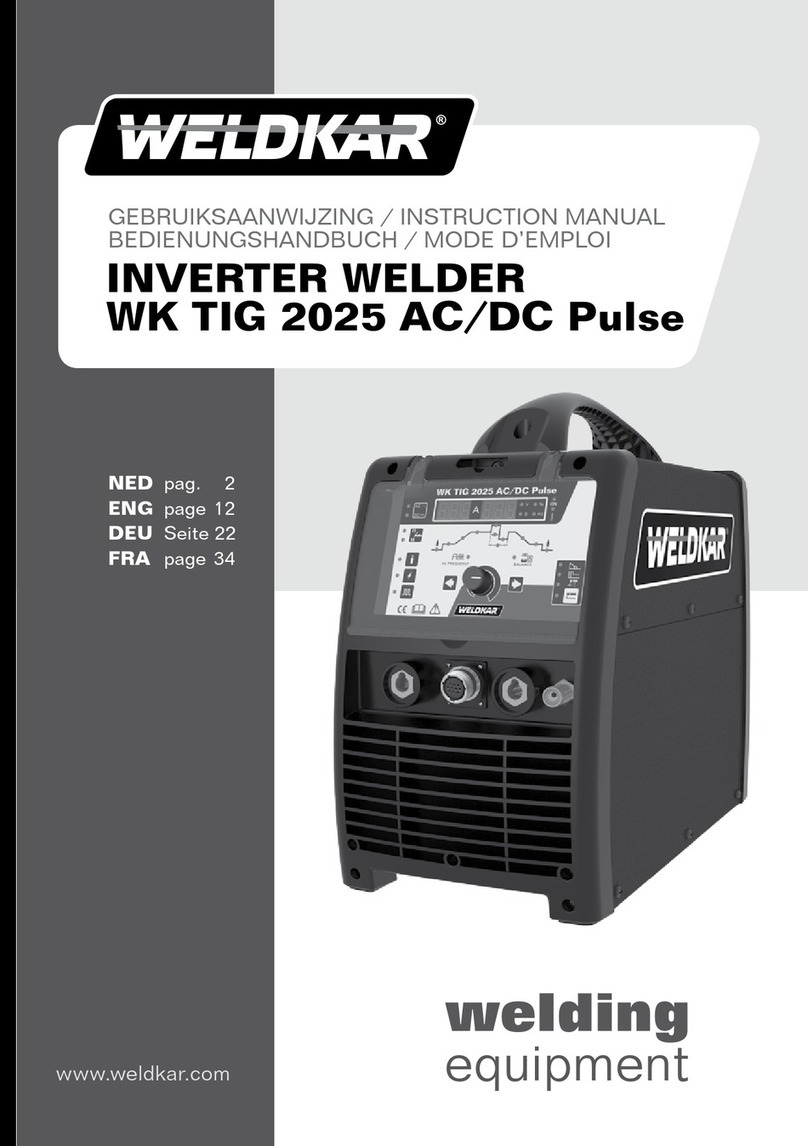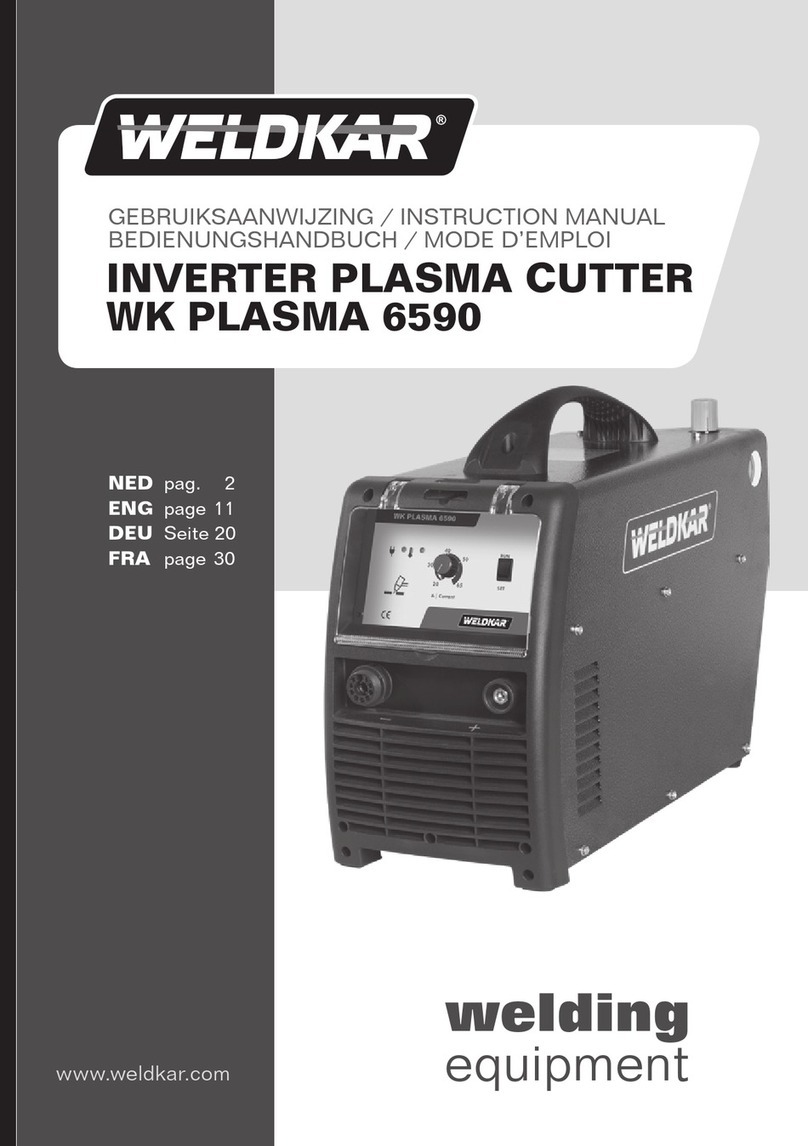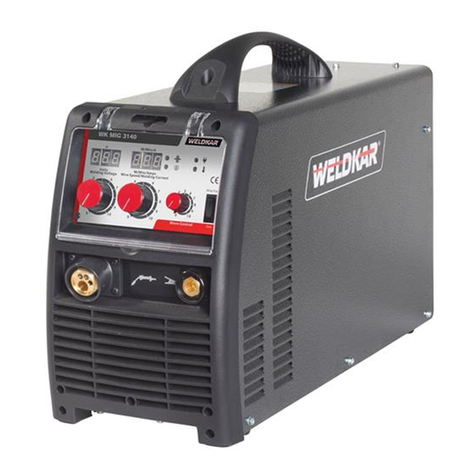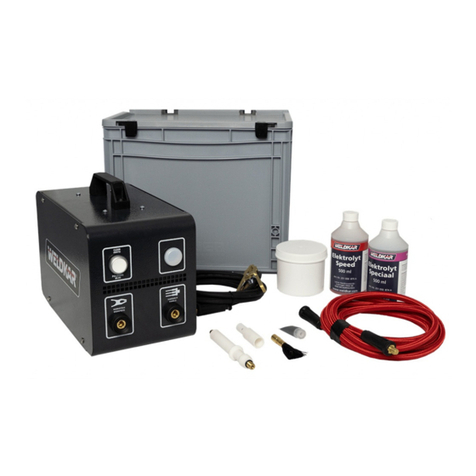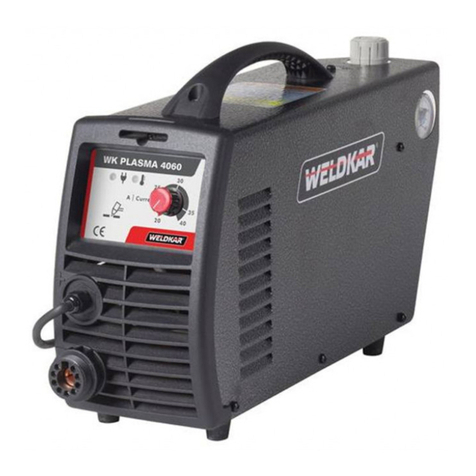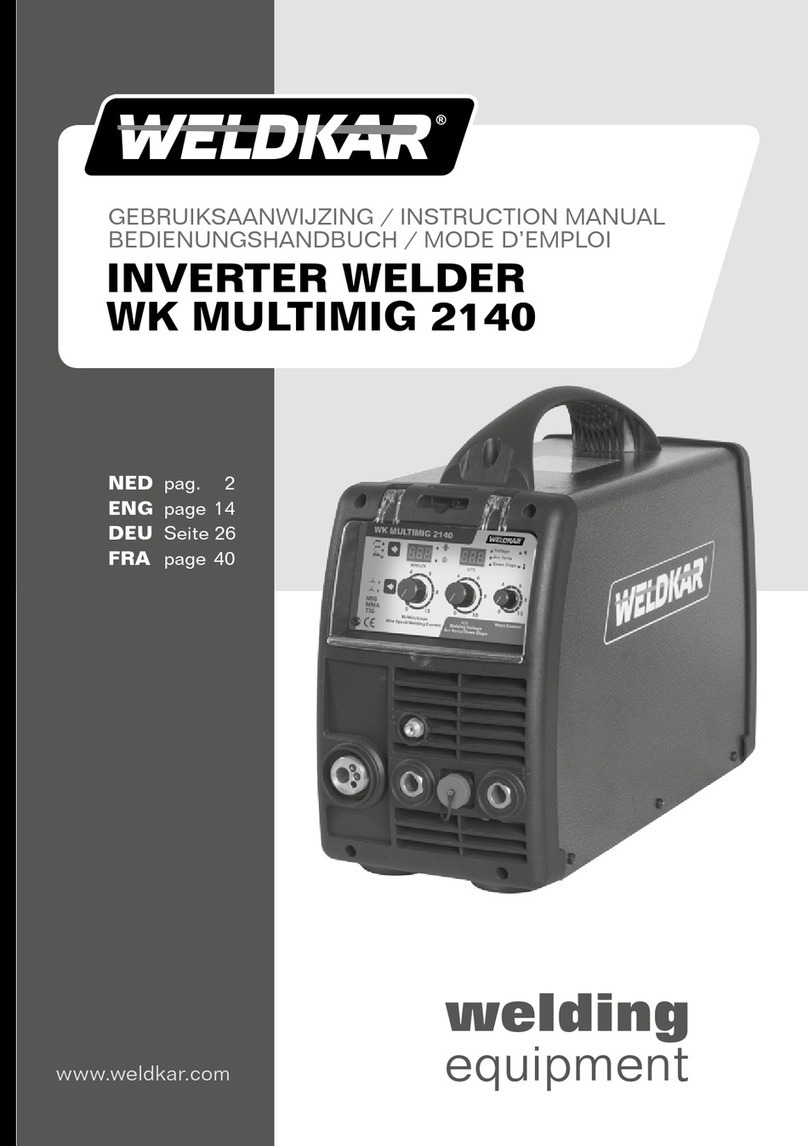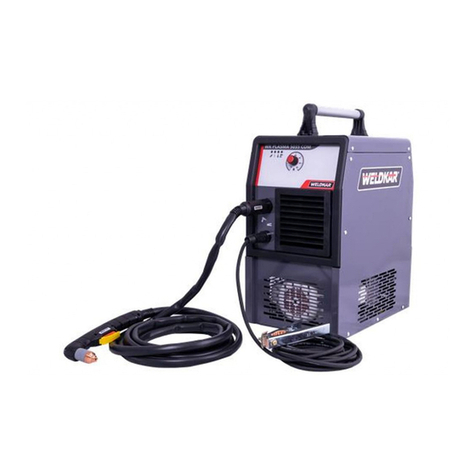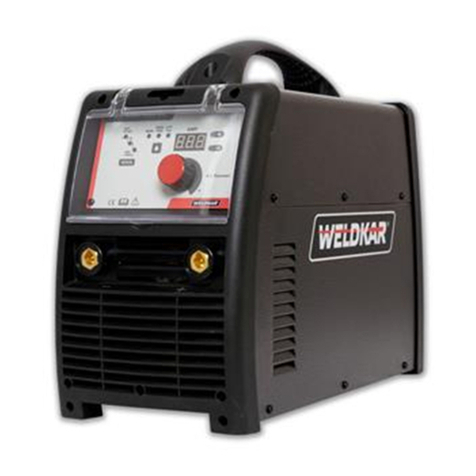
3
1. VEILIGHEIDSINSTRUCTIES EN
WAARSCHUWINGEN
1.1GEVAREN VERBONDEN AAN
HET BOOGLASSEN
WAARSCHUWING
ELEKTRISCHE SCHOKKEN
kunnen dodelijk zijn.
Het aanraken van onder spanning staande elektrische
onderdelen kan tot fatale schokken of ernstige
brandwonden leiden. De elektrode en het elektrische
circuit staan altijd onder spanning wanneer de uitgang
is ingeschakeld. Het circuit van de voedingsspanning
en de interne circuits van de machine staan eveneens
onder spanning wanneer de stroom is ingeschakeld. Bij
halfautomatisch of automatisch lassen met lasdraad
staan de draad, spoel, aandrijfrol behuizing en alle
metalen onderdelen die de lasdraad raken, onder
spanning.
1. Raak geen onderdelen aan die onder spanning
staan.
2. Draag droge, isolerende handschoenen zonder
gaten en een lichaamsbescherming.
3. Isoleer uzelf van het werkstuk en de grond met
droge, isolerende matten of afdekkingen.
4. Koppel de stroombron los of stop de motor voordat
u deze apparatuur installeert of onderhoudt.
Vergrendel de hoofd voedingsschakelaar in de
open stand of verwijder de hoofdzekeringen om te
voorkomen dat de spanning per ongeluk kan worden
ingeschakeld.
5. Installeer en aard deze apparatuur volgens
de gebruikershandleiding en de landelijke en
plaatselijke voorschriften.
6. Schakel alle apparatuur UIT wanneer deze niet in
gebruik is. Schakel de stroom naar de apparatuur uit
als deze onbeheerd wordt gelaten of buiten dienst
wordt gesteld.
7. Gebruik volledig geïsoleerde elektrodehouders.
Steek de houder nooit in water om hem af te koelen
en leg hem nooit op de grond of het werkvlak. Raak
nooit tegelijkertijd elektrodehouders aan die zijn
verbonden aan twee lasmachines en raak geen
andere mensen met de houder of de elektrode.
8. Gebruik geen versleten, beschadigde, ondermaatse,
of slecht verbonden kabels.
9. Wikkel de kabels niet om het lichaam.
10. Aard het werkstuk voor een goede elektrische
aarding.
11. Raak de elektrode niet aan terwijl hij in contact is
met het werkcircuit (aardingsketen).
12. Gebruik alleen goed onderhouden apparatuur.
Repareer of vervang beschadigde onderdelen
onmiddellijk.
13. Gebruik in gesloten of vochtige ruimten geen
lasapparaat met een AC-uitgang tenzij hij is
uitgerust met een spanningsreductie apparaat.
Gebruik apparatuur met een DC-uitgang.
14. Draag een veiligheidsharnas om vallen te voorkomen
bij het werken boven het vloerniveau.
15. Houd alle panelen en afdekkingen goed op hun
plaats.
WAARSCHUWING
BOOGSTRALEN kunnen de ogen en
de huid verbranden; LAWAAI kan het
gehoor beschadigen.
Boogstralen van het lasproces produceren intense hitte
en krachtige ultraviolette stralen die de ogen en de huid
kunnen verbranden. Lawaai van sommige processen kan
het gehoor beschadigen.
1. Draag een lashelm voorzien van de juiste filtertint
om tijdens het lassen of het kijken uw gezicht en
ogen te beschermen.
2. Draag een goedgekeurde veiligheidsbril. Zijkapjes
worden aanbevolen.
3. Gebruik beschermende afschermingen of barrières
om anderen te beschermen tegen het flitsen en
schitteren; waarschuw anderen dat ze niet in de
boog moeten kijken.
4. Draag beschermende kleding gemaakt van
duurzaam, moeilijk ontvlambaar materiaal (wol en
leer) en voetbescherming.
5. Gebruik goedgekeurde oordopjes of oorbeschermers
als het geluidsniveau hoog is.
6. Draag tijdens het lassen nooit contactlenzen.
WAARSCHUWING
DAMPEN EN GASSEN
kunnen uw gezondheid schaden.
Bij het lassen komen dampen en gassen vrij. Het
inademen van deze dampen en gassen kunnen uw
gezondheid schaden.
1. Houd uw hoofd uit de dampen. Adem de dampen
niet in.
2. Indien u binnen werkt moet u de ruimte goed
ventileren en/of een afzuigkoker bij de boog
gebruiken om de lasrook en -gassen te verwijderen.
3. Bij een slechte ventilatie moet u een goedgekeurd
ademhalingstoestel met luchttoevoer gebruiken.
4. Lees de veiligheidsinformatiebladen en de
aanwijzingen van de fabrikant voor metalen,
verbruiksgoederen, coatings en reinigingsmiddelen.
5. Werk alleen in een gesloten ruimte als die goed is
geventileerd, of wanneer u een ademhalingstoestel
met luchttoevoer gebruikt. De bij het lassen
gebruikte schermgassen kunnen de lucht
verplaatsen en letsel of de dood veroorzaken. Zorg
ervoor dat de lucht voor het ademen veilig is.
6. Las niet op plaatsen in de buurt waarvan
ontvettings-,reinigings- of spuitwerkzaamheden
plaatsvinden. De hitte en stralen van de boog
kunnen met dampen reageren om zeer giftige en
irriterende gassen te vormen.
7. Las niet op gecoate metalen zoals gegalvaniseerd
staal of staal bekleed met lood of cadmium, tenzij
de coating is verwijderd van het lasgebied, de
ruimte goed is geventileerd en, indien nodig, u
een ademhalingstoestel met luchttoevoer draagt.
De coatings en alle metalen die deze elementen
bevatten kunnen giftige dampen afgeven tijdens het
lassen.
engdeufra ned
